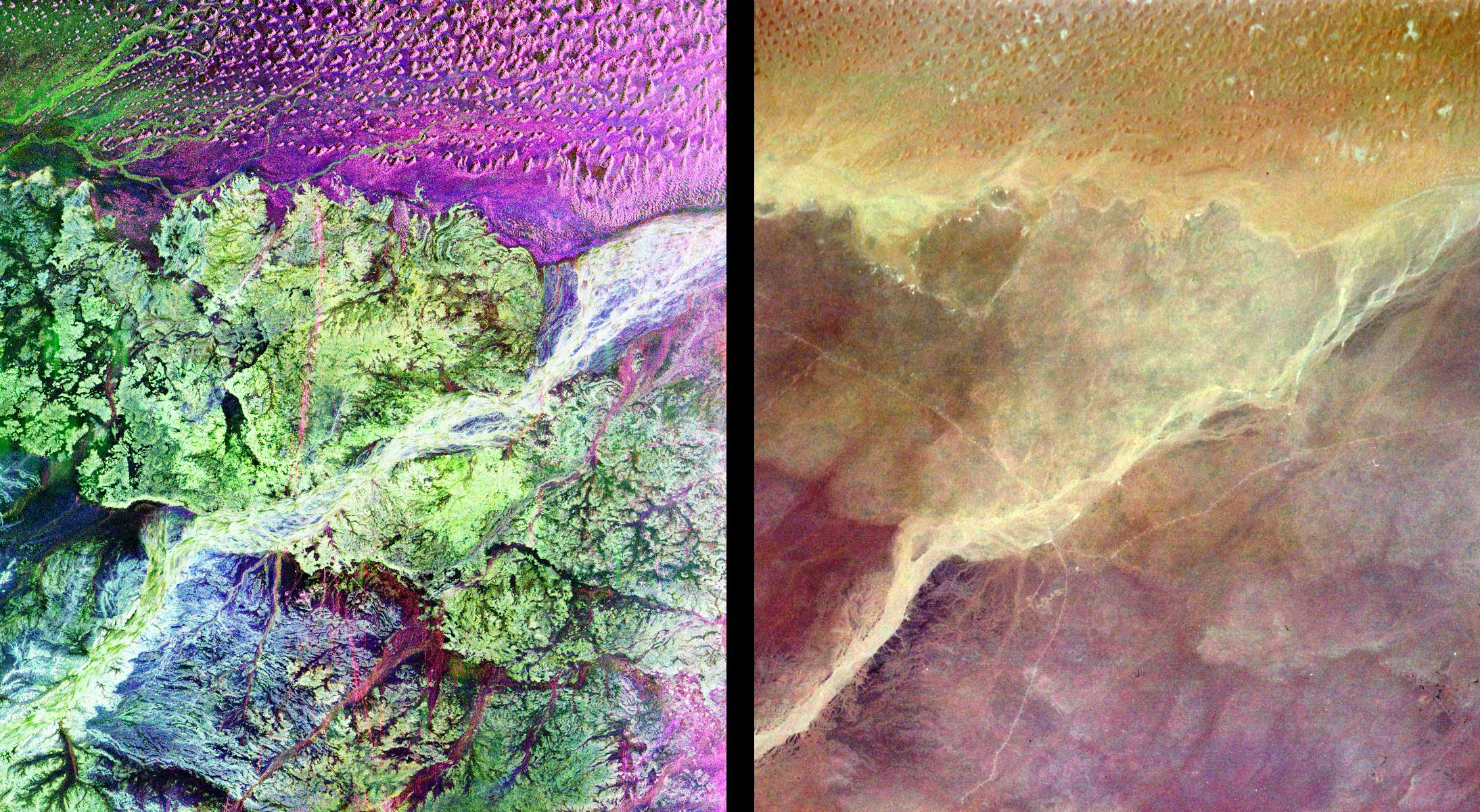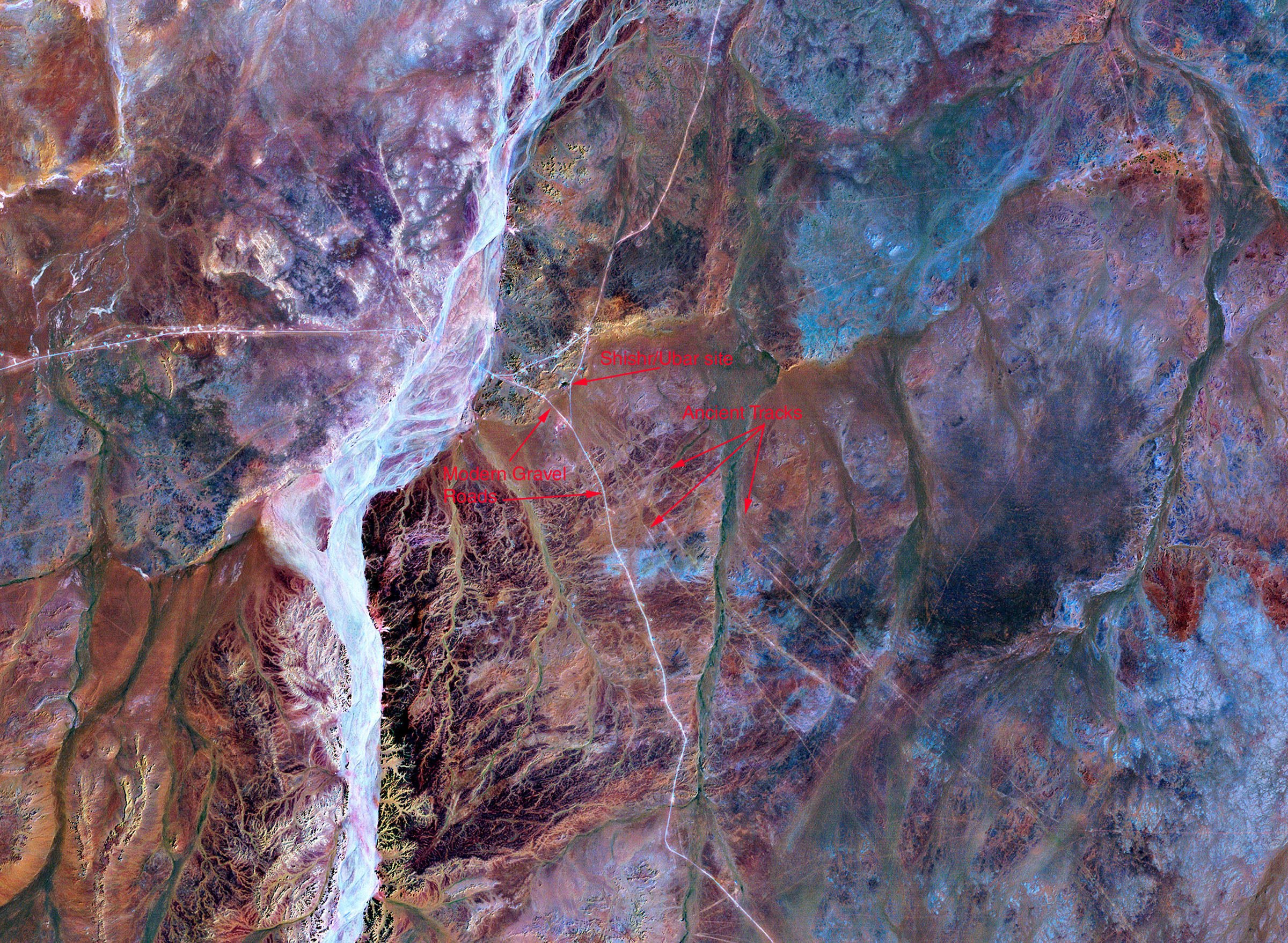What was the most important physical feature needed for a civilization to grow and prosper?
The search for the fabled urban center of Ubar began with a cold phone call to NASA'due south Jet Propulsion Laboratory (JPL) in 1982.
Documentary filmmaker Nicholas Clapp had heard stories most a lost settlement in the Arabian Desert that was in one case teeming with riches. At some bespeak many centuries ago, Ubar had disappeared into the sand and Clapp wondered if he might use NASA spacecraft to look for it.
"When he called, he was manifestly not function of the lunatic crowd we often become calls from," says Dr. Ron Blom, Programme Managing director for Solid Globe Scientific discipline and Natural Hazards at NASA's JPL. "Nick stood out because he had actually washed quite a fleck of homework."
And and then the search began.
Ancient outpost
Using Clapp's historical inquiry as a guide, Blom and his team used the space shuttle Challenger to take images that allowed them to detect ancient tracks in the desert. Some of the roads ran beneath modern sand dunes merely all of them converged on a cardinal bespeak: in southern Oman in the Middle Due east. There, archaeological excavations showed that the squad had indeed located a site that matched some descriptions of the legendary Ubar, which it turned out had actually been an important water source and a desert outpost where camel caravans assembled to send frankincense.
Shifts in climate – both large and small – are at least partly responsible for the ascent and autumn of many aboriginal civilizations.
In one case surrounded by mighty towers that eventually sunk into the sand, Ubar is just one in a growing listing of aboriginal sites that are emerging with help from satellite imagery. As well known as "remote sensing data", images taken from high above the surface of the World can bear witness subtle signs of long-lost societies that are impossible to see from the basis.

As scientists dig in to these sites, they are turning upward show that changes in climate – both big and small – are at least partly responsible for the ascension and fall of many ancient civilizations. Even though Ubar is now located in i of the driest places on Earth, the region was once much wetter and underground h2o sources were plentiful. Ubar disappeared when h2o levels dipped so low that a sinkhole formed and enveloped the outpost.
An Egyptian kingdom, likewise, complanate during an extended drought 4,200 years agone. Droughts have also been linked to the fall of the Maya effectually 900 Advert and the demise of the spectacular Cambodian city of Angkor in the early on 1400s.
A stable climate ensures crops grow yr after yr, and a reliable source of food frees people to settle down and develop civilization.
Earth from above
It's not surprising that climate change has doomed so many populations, Blom says. After all, it was when weather patterns finally became anticipated about 11,500 years agone that circuitous civilizations finally formed in the start identify. A stable climate ensured that crops would grow twelvemonth subsequently year, and a reliable source of food freed people to settle downwardly and develop culture.
Since then, many civilizations take blossomed into greatness and subsequently disappeared into rubble. Equally scientists try to piece together the history of where people lived a long time ago, they are increasingly turning to the most modern of technologies: spacecraft that offer an unprecedented view of Earth from above.
There are a variety of means to spot long-buried settlements in satellite images. In the search for Ubar, Blom and colleagues used computers to enhance images taken in the visible and infrared wavelengths, likewise every bit with radar, allowing them to peer up to 15 anxiety beneath the surface of dry sand. Equally they analyzed the sizes and proportions of dust, rocks and sand grains, they could see the boundaries of ancient roads.
When nosotros excavate the remains of past civilizations, we rarely find whatever evidence that they made whatsoever attempts to conform in the face of a changing climate. I view this inflexibility as the real reason for collapse.

In modernistic-24-hour interval Republic of iraq and Syria, Harvard archaeologist Jason Ur and colleagues have used NASA satellite images to identify thousands of possible locations for ancient Mesopotamian cities past looking for patches of lighter, drier soil. Those spots indicate where mud brick structures may have collapsed.
Change or perish
In the case of the Maya and other lost cities in Primal and Due south America, the jungle is quick to grow over ancient buildings and other structures, but scientists look to satellite imagery for slight differences in vegetation patterns. Where once in that location was development, the soil is stressed enough to support plants that are dissimilar from those growing in untouched soils. Seeing those vegetation shifts from above helps archaeologists zero in on where to dig.
"Lowland Amazonia is bigger than the continental United States," says William Wood, a geographer and archeologist at the University of Kansas, Lawrence. "The merely way of discovering these new things is with remote sensing and on-the-basis truthing [measurement verification]."
Every bit archaeologists go on to turn upwards e'er more signs of collapsed civilizations, they are finding enough of show that climate shifts are at least partly to arraign for the turn down in many cases. Those links offering the opportunity to protect the future of our own society by learning from the mistakes of our ancestors.
"When we excavate the remains of by civilizations, we very rarely find any evidence that they as a whole social club fabricated any attempts to modify in the confront of a drying climate, a warming atmosphere or other changes", Ur says. "I view this inflexibility as the real reason for plummet."
"Today we have an unbelievable ability to learn well-nigh our environment and communicate what we learn to all of club," he adds. "Nosotros need to take amend reward of our advice engineering science advances in the face of a changing climate."
Source: https://climate.nasa.gov/news/1010/climate-change-and-the-rise-and-fall-of-civilizations/
0 Response to "What was the most important physical feature needed for a civilization to grow and prosper?"
Post a Comment